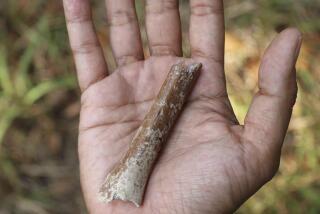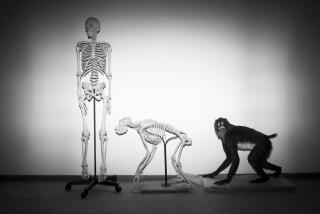Tool making arose earlier among human ancestors
Our ape-like ancestors may have stopped dragging their knuckles and started making tools a half million years earlier than previously thought, according to a new study.
The study, published online Thursday in the journal Science, suggests that the art of tool making may not be exclusive to the genus Homo, which led to modern Homo sapiens. At least one species in the dead-end genus Australopithecus appears to have enough of the hand characteristics that would have made tool crafting possible, the study found.
That would mean that the credit for tool use would now be shared between Homo habilis -- most often thought to be the progenitor of tool-making hominins -- and Australopithecus africanus, a species that wandered around southern Africa about 2-3 million years ago.
Since then, modern Homo sapiens has used a lot of his tool-making ability to type out arguments over which ancestor first flaked a stone into a sharp-edged tool. So itŌĆÖs unlikely that one study will settle the matter.
But a research team led by the University of Kent makes a compelling case for a special kind of handiness in A. africanus.
They compared the density and shape of hand bones across multiple species spanning several million years. They were particularly interested in the metacarpal bones, which span the palm, connecting the digits to the wrist area. These are the bones that boxers fracture when punching, or soldiers crack when doing fist push-ups. They no longer are built for sustaining such force.
ThatŌĆÖs why the subtle changes in metacarpal bones, particularly the lower part of the thumb, hint at whether our ancestors still largely swung from trees or had freed their forelimbs for more delicate work.
The fossil record, however, is incomplete. The oldest evidence of tools coinciding with fossilized hand bones suggests H. habilis was crafting tools about 2.4 million years ago, though there is some evidence of tool-like stones a few hundred thousand years earlier.
But hominins didnŌĆÖt display the full suite of hand features to enable a powerful and precise grasp of tools until the emergence of Neanderthals about 200,000 years ago, although fragmentary evidence suggests the modern hand arose among Homo erectus, about 1.4 million years ago.
Researchers first took a closer look at the form and function of hands from ancient Egyptians and recent Europeans, and compared them with modern chimpanzees and bonobos. That gave them a more precise base of comparison when they turned to A. africanus.
They found that the heads and bases of the metacarpal bones became less dense among more modern hominins, and that density shifted toward the palm ŌĆō an indication that the hand became fortified for the types of forces associated with precise squeezing of the thumb toward the fingers.
That doesnŌĆÖt mean A. africanus had a modern hand. It didnŌĆÖt. Like a lot of early hominins, much of its hand structure and bone density was still suited for curling around tree limbs, the authors noted.
One of the toughest problems of sorting out evolutionary changes is figuring out which changes eventually mattered. While it is generally accepted that the advantages of tool making put selective pressure on the features that improved forceful precision, other aspects of hand structure could have lingered.
But at least in theory, Australopithecus probably could have had as firm a handshake as Homo, the study suggests.
If you dig paleontology, follow me on Twitter: @LATsciguy






